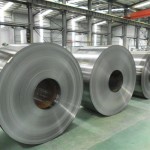Coil processing equipment includes straightening, leveling, blanking, stacking, uncoiling and recoiling.
 Sheet metal, as we know, comes in numerous widths and thicknesses and for this reason is typically coiled to assist in smooth handling and additional processing. The primary follow-up procedures, using the aforementioned equipment, are as follows:
Sheet metal, as we know, comes in numerous widths and thicknesses and for this reason is typically coiled to assist in smooth handling and additional processing. The primary follow-up procedures, using the aforementioned equipment, are as follows:
- Slitting the metal into individual, narrower coils
- Blanking the metal into different shapes and sizes
Coil Slitting
Starting with the original coil, sharp rotary blades called knives cut their way through the sheet metal lengthwise, creating the narrower strips. A wide range of materials can be slit, ranging from thin foils to thick plate. After the uncoiler has done its job, the coil runs through the slitter with one upper blade and one lower blade meeting the metal. The recoiler then takes its turn on the slitter, and recoils the processed strips, using separator discs which prevent the resultant narrower coils from tangling with each other.
Coil Blanking
Blanks of all shapes and sizes are produced from coiled stock using either shearing lines or blanking presses. To achieve the necessary flattened results, the coiled metal is put through a straightener or leveler. The blanks are then sheared to size. Shearing is good for regular shapes, but blanking presses are used for complex and irregular shapes. Holes and slots may also be produced during blanking.
A key point to note, according to Smart Manufacturing Magazine, is that, for high production coil operations, a continuous and uninterrupted flow of coil stock is needed. “For this purpose, coil-to-coil welding stations are placed so that the leading edge of the new coil can be welded to the trailing edge of the previous coil, eliminating the need to thread a new coil into the line. To facilitate the welding, a coil or strip accumulator is used to hold enough coil to keep the line running while the weld is taking place.”
Many Facets
This is just one example of the many facets of coil processing. There’s considerably more to discover, including how it can improve the efficiency of roll-forming and duct work manufacturing as well as sheet metal stamping operations.
For example, take Iowa Preceision’s CL-Plus Coil Line product, which covers the waterfront in terms of the options it offers, as follows:

Two coil storage locations handle material up to 18 gauge thick and 60″ wide. The base machine includes standard SMACNA bead, 3/16″ maximum depth, 5 beads with 12″ center distance, for coil up to 60″ wide. Standard configurations include:
- Combination Shear-Brake for forming male flange on the lead edge of the blanks
- Combination Shear-Brake with Button Punch for BPSL seamed Duct
Additionally, the CL-Plus Coil Line can include Notching, so the blanks coming off the machine are ready to be roll formed and bent into “L” or full wrap rectangular HVAC Duct:
- Optional Notch Unit to prepare blanks for slip or Pittsburgh
- Optional Notch dies for Tie Rod Punching of Duct
This is just one of the many coil processing solutions offered by Iowa Precision. But don’t recoil from the avalanche of choices. We’ll level with you at every stage of your inquiries. That’s a blankety-blank straight promise!

